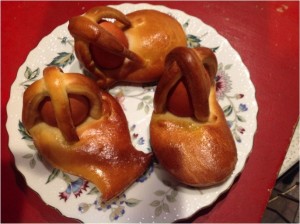By Shelley Adatto Baumgarten, Jewish Sound Columnist
The festival of Purim falls on the 14th day of the month of Adar, which is early springtime. Purim, the Hebrew word for lottery, is a great cause for rejoicing. After all, we recall Queen Esther, after concealing her Jewish identity for the sake of safety, approached the king to inform him of the villainous Haman’s plot and date — apparently chosen by lottery — to kill the Jews of ancient Persia. Esther’s words prevailed and the king ordered Haman and his sons to perish.
On Shabbat before Purim, known as Shabbat Zachor (when the Torah portion mentions Haman’s ancestor, Amalek), many Sephardim, especially from Turkey and Greece, prepare and eat foulares. A foulare is an age-old savory yeasted pastry, sometimes flecked with bits of cheddar cheese, topped with a hard-boiled egg and then baked.
In some Sephardic communities, it is customary to tint the eggs brown using onion skins. The shape of the dough, after being rolled and cut, is intended to represent either Haman’s foot or jail cell. After we form the dough, we fasten the egg, which symbolizes Haman’s head or eyes, to this base. Interestingly, the three-step preparation of a foulare follows the process where Haman was captured and arrested (the making and shaping of the dough), jailed (strips of dough placed on the egg), and then killed (baking the Foulare).
The foulare, unfortunately, does not have a well-documented history. Perhaps eating the pastry is a great symbolic way to gobble-up and get rid of Haman. However, in his book, “A Drizzle of Honey,” David Gitlitz mentions that the foulare may be connected to Conversos living in Spain around 1492. You can find another theory about their origin in the article “What’s Inside? Hidden Foods for Purim,” in which Ruth Abusch Magder draws a parallel between Purim and stuffed or “hidden” foods like hamantaschen with its filling underneath pastry dough. You can possibly categorize foulares as one of these foods. Although not a stuffed pastry, the foulare’s egg is concealed, if you will, because of its shell, making it similar to one of those pastries.
The foulare is a fun and visually delightful pastry to make. Both children and adults will enjoy preparing and forming the dough, and criss-crossing and fastening the eggs to the base. While it bakes, your house will be perfumed with the most magnificent scent of freshly made yeasted bread. The bread is similar in texture and taste to challah, and because of the roasted egg, each foulare is quite filling, almost like eating an egg sandwich. When served with a bowl of lentejas (lentil soup) and a simple salad of lettuce and tomatoes, the trio forms a complete meal perfect in protein, carbohydrates and greens. Be sure to eat them while still warm (at their best) although they also taste amazing right out of the refrigerator. You can even get creative —my husband smears spicy brown mustard on top.
Foulares
1/2 recipe Basic Sweet Yeast Dough (recipe follows)
12 haminados (Sephardic brown eggs or regular hard-boiled eggs in their shells)
Egg wash (1 large egg beaten with 1 tsp. water)
Prepare the dough through Step 7.
On a lightly floured surface, roll out the dough 1/4 inch thick. Cut out 12 3-inch shapes, either foot-shaped or round cookie cutter. Cut the remaining dough into thin strips. Place an egg, large end down, and press it lightly into the dough. You may have to bring a bit of the dough up around it and secure it with three thin strips in a crisis-cross fashion. Place on a baking sheet lined with parchment paper, cover, and let rise until double in bulk, about 75 minutes.
Preheat oven to 350º.
Brush the dough with the egg wash and bake until golden brown, about 20-30 minutes. Transfer to a rack and let cool.
Basic Sweet Yeast Dough
1 (1/4 oz.) package or 2-1/4 tsp. active dry yeast
1 cup warm water (105 to 115º)
1/3 cup of sugar
1/3 cup vegetable oil
2 large eggs
1 tsp. salt
4 cups unbleached all-purpose flour
In a food processor, combine flour, salt and sugar (minus 1 tsp. of sugar, which you will use for the yeast.)
Assemble the eggs and oil and have them ready to use.
Dissolve the yeast in 1/4 cup of warm water. Stir in the teaspoon of sugar and let stand until foamy, 5-10 minutes.
With the machine on, add the dissolved yeast mixture to the flour, then the eggs and oil.
Gradually add enough of the warm water to form a ball of dough that cleans the sides of the bowl. Process around the bowl 25 times then let the dough stand for 2 minutes to absorb any extra liquid. If the dough seems dry, just add a little more water and process.
Place in an oiled bowl, cover and let rise until doubled in bulk — 1-1/2 to 2 hours.
Punch down. Fold the dough over itself 5 times. Let stand for 10 minutes then use in recipe.
Makes 12 Pastries
Avid professional baker and culinary writer Shelley Adatto-Baumgarten looks forward to teaching Sephardic cuisine at North Seattle College and other locations this spring.